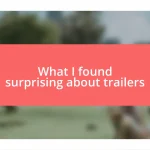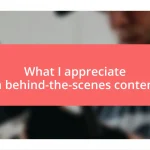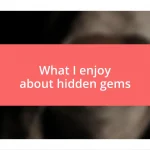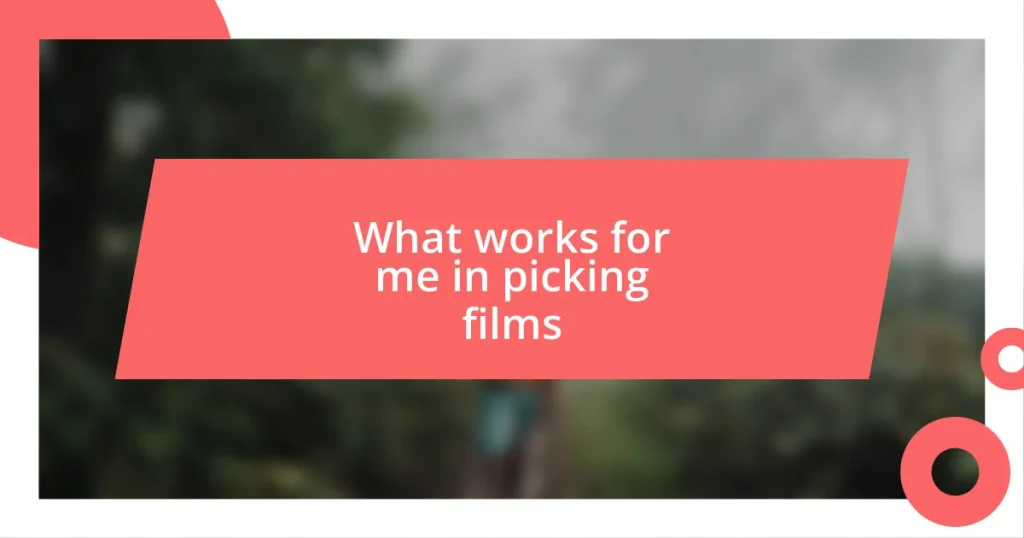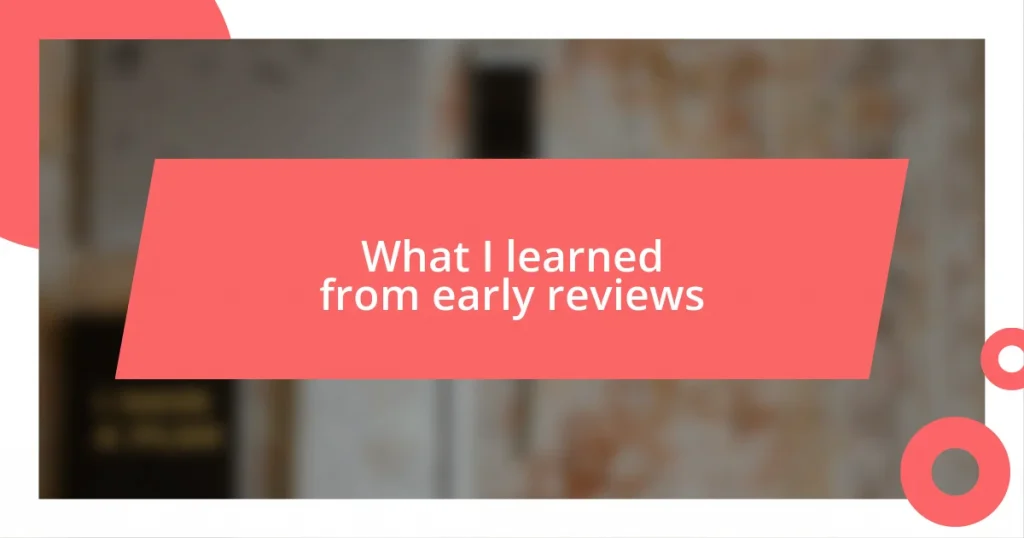Key takeaways:
- Experimental film prioritizes visual and auditory expression over traditional narrative, often evoking deep emotional responses through unconventional techniques.
- Historical movements like Surrealism and Dadaism have significantly influenced experimental filmmaking, encouraging the exploration of new artistic boundaries and collective audience experiences.
- Future trends in experimental film include the integration of digital technology, immersive storytelling, and interactive elements, enhancing viewer engagement and emotional connections.

Understanding Experimental Film Techniques
Experimental film techniques challenge traditional narrative structures, often prioritizing visual or auditory expression over story. I remember watching a short film that relied heavily on abstract visuals—no dialogue, just a symphony of colors and shapes that evoked emotions I couldn’t quite articulate. It made me wonder, how often do we overlook the emotional power of visual storytelling in our haste to understand a film’s plot?
These techniques can involve unconventional camera angles, non-linear editing, or even performance art elements woven into cinema. For instance, during a project of my own, I employed extreme close-ups on mundane objects, which transformed them into characters of their own. This approach opened my eyes to the concept that even everyday items can convey deep emotional narratives if presented in an engaging way.
Many filmmakers embrace the unexpected by manipulating sound, light, or even the physical space of the viewing experience. I still recall a screening where the film’s background noise became disturbingly loud, immersing me fully in the character’s turmoil. Was it discomforting? Absolutely. Yet, that’s the beauty of experimental film—it pushes viewers to confront their feelings, often generating profound reflections long after the credits roll.

History of Experimental Film
Experimental film has roots that stretch back to the early 20th century, when artists began using film as a canvas for artistic expression rather than mere storytelling. I remember being fascinated by the works of filmmakers like Maya Deren and Stan Brakhage. Their films, laden with dreamlike sequences and often lacking traditional narratives, taught me that cinema could be a visual poem, inviting viewers into an abstract realm of emotions.
As I explored the evolution of experimental film, I noted the significant influence of movements like Surrealism and Dadaism, which encouraged artists to challenge societal norms. This exploration reminded me of a time when I attended an avant-garde film festival, where the audience was invited to react to the film. It was exhilarating to share that raw, unfiltered experience with others, emphasizing how experimental film fosters community through collective emotional engagement.
Today, experimental films continue to evolve, embracing digital technology and interactive elements. I’ve seen how these advancements allow filmmakers to blur the lines between creator and viewer, creating immersive experiences that resonate deeply. Reflecting on my own projects, the use of technology opened a new world of possibilities for expression, making me wonder how far we can push the boundaries of film as an art form.
| Period | Significant Developments |
|---|---|
| Early 20th Century | Pioneers like Maya Deren and Stan Brakhage focused on visual storytelling over narrative. |
| 1920s-1940s | Influence of Surrealism and Dadaism on film techniques and artistic expression. |
| Modern Era | Integration of digital technology and interactive elements, transforming viewer engagement. |

Key Characteristics of Experimental Films
Experimental films are often recognized by their unique, liberated approach to storytelling and visual expression. For me, one standout quality is the rejection of traditional narrative structure. I recall a film I watched where the plot seemed almost irrelevant; instead, it was the rhythm of the visuals that captured me. It felt like stepping into a dream where logic took a backseat, allowing pure sensory experience to thrive.
Here are some key characteristics that define experimental films:
- Non-Linear Narratives: The story unfolds in unexpected ways, often resembling a collage of experiences rather than a straightforward progression.
- Focus on Visuals and Sound: Strong emphasis on visual aesthetics and auditory elements, allowing them to convey emotions independently of the narrative.
- Unconventional Techniques: Innovative editing, camera angles, and special effects challenge the norms of mainstream film making.
- Engagement with the Audience: Rather than providing passive entertainment, these films invite viewers to actively participate in the interpretation of meaning—often evoking personal reflections.
- Exploration of New Media: The use of emerging technologies and interactive formats expands the field, creating shared experiences that blur the lines between artist and audience.
Reflecting on my experiences, I often think about the times when I felt utterly absorbed in an experimental piece, seemingly struck by its rawness. In one memorable instance, I found myself surrounded by darkness as a light flickered softly, leading to moments of introspection that felt deeply intimate. The film didn’t tell a traditional story, yet it resonated with my emotions in a way that felt profoundly personal. It’s this kind of connection that makes experimental films an intriguing exploration of the human experience.

Types of Experimental Film Techniques
When it comes to experimental film techniques, one prominent method is the use of found footage. By repurposing existing material, filmmakers can create entirely new narratives or evoke a particular emotion. I vividly recall watching a piece that skillfully spliced together mundane scenes from old documentaries, transforming them into a haunting commentary on societal apathy. It made me wonder: how can the mere act of recontextualization reveal so much about our world?
Another fascinating technique involves performance art integrated with film. Some experimental filmmakers utilize live performances to blur the lines between the screen and reality. I experienced this firsthand at a gallery where actors interacted with the projected imagery, creating an immersive environment that was both disorienting and enchanting. It struck me how this approach challenged the concept of a passive audience—each viewer became a part of the unfolding experience.
Lastly, there’s the captivating allure of abstract visual techniques. These films often rely on colors, textures, and shapes rather than traditional storytelling. I remember becoming completely absorbed in a work that used swirling patterns and rhythmic soundscapes to convey emotions that words simply couldn’t express. It led me to reflect on how artistry can transcend language, speaking instead through the visceral impact of imagery alone. Isn’t it mesmerizing how a simple arrangement of shapes can evoke such a deep emotional response?

Practical Applications of Techniques
Exploring the practical applications of experimental film techniques has truly enriched my creative process. For instance, I often use found footage in my own projects. This technique allows me to weave new narratives from snippets of existing works, which can lead to surprising emotional discoveries. Once, I edited together clips from old travelogues to create a piece that commented on how tourism transforms local cultures; the collision of past and present in those images left me—and my audience—reflecting on our global impact in unexpected ways.
When it comes to integrating performance art with film, I’ve found that this technique can create an extraordinary connection between the audience and the narrative. In one particular project, I invited dancers to perform alongside a projected film—a blend of movement and imagery that felt almost symbiotic. This approach fostered an atmosphere of active participation, as viewers became witnesses to a dance that reflected their own emotions. How powerful is it to consider that the act of watching can transform into an interactive experience?
I’ve also experimented with abstract visual techniques in my own storytelling. There’s something liberating about letting visuals take precedence over narrative. During one of my experimental shorts, I focused on colors shifting and morphing in rhythm with an evocative score, aiming to evoke feelings of nostalgia without a defined plot. I can’t help but wonder: can pure visual expression speak to the heart more profoundly than words? This creates an opportunity for each viewer to interpret their experience uniquely, allowing a deeply personal connection to the art on screen.

Case Studies in Experimental Film
One particularly striking example of experimental film that comes to mind is Ken Jacobs’ “Tom, Tom, the Piper’s Son.” This film utilizes a unique technique called optical sound to create a layered experience that invites viewers to reevaluate what they see and hear. I remember sitting in a small theater, completely captivated as the manipulated visuals transformed an old silent film into a vibrant dialogue between the past and my present sensibilities. It made me ponder how the act of disrupting the norm can push our understanding of cinema in profound ways.
Another exhilarating case is Yoko Ono’s “Film No. 4 (Bottoms),” where she allows us to witness the human body in a raw and unfiltered light. Watching this film stirred in me a mix of discomfort and thoughtfulness, as I grappled with the very essence of art and vulnerability. In this work, I realized it’s not just about what is shown but also about the questions it raises about society’s perceptions of beauty and the body. Doesn’t it make you think about how powerful rawness can be in revealing deeper truths?
Lastly, I think of Bob Dylan’s “Don’t Look Back,” a documentary that subtly experiments with the form by blending interviews and performances in an almost stream-of-consciousness style. I recall feeling transported into Dylan’s world, where music and thoughts intertwined seamlessly. It left me asking: how can the spontaneity of a moment captured on film resonate with us more deeply than meticulously staged productions? The freedom to explore life in its unfiltered state can be a striking departure from conventional storytelling, isn’t it?

Future Trends in Experimental Film
As I look toward the future of experimental film, one trend that excites me is the increasing use of digital technology and virtual reality. This is not just about enhancing visuals but about immersing audiences in entirely new realms of storytelling. I recently tried a VR film that placed me in the middle of an animated world—a sensation that felt almost like stepping inside an artist’s canvas. Isn’t it fascinating how technology can create an intimate connection between the viewer and the narrative, transforming passive observation into active exploration?
Another captivating development is the blending of diverse media, such as integrating graphic novels or video games into the filmic experience. I remember attending a screening where the film was accompanied by live sound effects created by a comic artist. The synergy between the visuals and the sounds transported me to a place where I felt both the story and its artistic representation were breathing together in harmony. How unique is it to witness hybrid art forms evolving side by side, potentially redefining the boundaries of what we consider a film?
Lastly, the rise of interactive storytelling ways is where I see immense potential for future experimental films. Imagine engaging with a narrative where your choices shape the flow and outcome of the film. Recently, I explored an interactive short that led me down different paths based on my decisions. Each choice influenced not only my experience of the story but also my emotional reaction to it—making this film feel more like a personal journey. Could this be the key to deeper emotional connections between film and viewer? The possibilities seem endless, and I eagerly await where this creative exploration will take us next.




